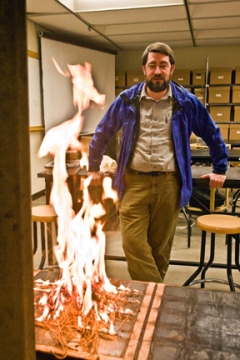(Revised @ 2:50 MT, April 26, 2010)
More information has come to light regarding the article we wrote last week about “Cancer risk and smoke exposure among wildland firefighters“. In response to an email, we heard from Brian Sharkey of the USFS’ Missoula Technology and Development Center, an exercise physiologist who was instrumental in the design of the Step Test and Work Capacity Test for wildland firefighters. We asked Mr. Sharkey if he was aware of any studies that considered a possible increased cancer risk for wildland firefighters. He said no, and:
However, our 1997 risk assessment (Booze in Health Hazards of Smoke, 1997) showed an increased risk only when we used “worst case scenario” – which estimated career exposure at exposure levels 95% of highest values measured. No one works for 25 years anywhere near those values. Also, some carcinogens are not as high on fires as they are in winter (from burning wood in stoves) (Smith et al.).
Structural FF do not have increased risk of lung cancer. Chinese women who cook over coal fires have more cancer – those who cook over wood fires do not.
We need a study of health effects that looks at all causes of morbidity and mortality – not just cancer (where risk is about 1 in 3 for US population). We also need an injury/illness surveillance system that tells us the impact of fire on respiratory, cardiovascular and – yes – cancer.
We asked Mr. Sharkey what data supported his statement that “structural FF do not have an increased risk of lung cancer”, and he was in a hurry, about to leave for a “smoke meeting”, but referred to a study on Philadelphia firefighters. We found the 24-year old study to which Mr. Sharkey may be referring. Here is an excerpt, the Methods, Results, and Conclusions:
Methods
We conducted a retrospective cohort mortality study among 7,789 Philadelphia firefighters employed between 1925 and 1986. For each cause of death, the standardized mortality ratios (SMRs) and 95% confidence intervals were estimated. We also compared mortality among groups of firefighters defined by the estimated number of career runs and potential for diesel exposure.
Results
In comparison with U.S. white men, the firefighters had similar mortality from all causes of death combined (SMR = 0.96) and all cancers (SMR = 1.10). There were statistically significant deficits of deaths from nervous system diseases (SMR = 0.47), cerebrovascular diseases (SMR = 0.83), respiratory diseases (SMR = 0.67), genitourinary diseases (SMR = 0.54), all accidents (SMR = 0.72), and suicide (SMR = 0.66). Statistically significant excess risks were observed for colon cancer (SMR = 1.51) and ischemic heart disease (SMR = 1.09). The risks of mortality from colon cancer (SMR = 1.68), kidney cancer (SMR = 2.20), non-Hodgkin’s lymphoma (SMR = 1.72), multiple myeloma (SMR = 2.31), and benign neoplasms (SMR = 2.54) were increased among firefighters with at least 20 years of service.
Conclusions
Our study found no significant increase in overall mortality among Philadelphia firefighters. However, we observed increased mortality for cancers of the colon and kidney, non-Hodgkin’s lymphoma and multiple myeloma. There was insufficient follow-up since the introduction of diesel equipment to adequately assess risk. Am. J. Ind. Med. 39:463-476, 2001. Published 2001 Wiley-Liss, Inc.
Wildfire Today has called for a study on the cancer risks associated with wildland fire. Not just lung cancer. The study needs to be conducted by medical doctors and epidemiologists.
We also learned that a proposal was prepared by Joseph Domitrovich in December, 2008, for the US Forest Service Technology and Development Program to study the effects that carbon monoxide may have on the cognitive function of wildland firefighters. Here is an excerpt.
An extensive EPA review on CO effects (2000) concluded that behavioral impairments in healthy adults are not significant below 20% carboxy hemoglobin (COHb). However, some studies have showed mild impairments at 5% COHb or below. Cigarette smokers have COHb levels of 5-10%, sometimes as high as 15%. In view of the reported adverse effects among fire staff, suspect additive or synergistic interactions among pollutants that worsen the neurobehavioral effects that would be predicted from CO exposure alone.
PROPOSED TECHNOLOGY & DEVELOPMENT WORK:
The deliverable outcome of the proposed project is a report detailing the levels of smoke exposure and cognitive effects. This could then be used by IMT, crew bosses along with training (RX-410) to help better understand the potential cognitive effects when exposed to wildland fire smoke.
POTENTIAL BENEFITS:
This project will help us to better understand the effects of wildfire smoke on our cognition, which would increase safety of fire personal.
Wildfire Today recommends that this study be funded.
A “smoke meeting” is being held in Boise this week. It will interesting to see if anything that will benefit the health of firefighters will come out of the meeting. We understand that at least one actual medical doctor is beginning to be involved in smoke studies related to wildland firefighters, which is a step in the right direction.

